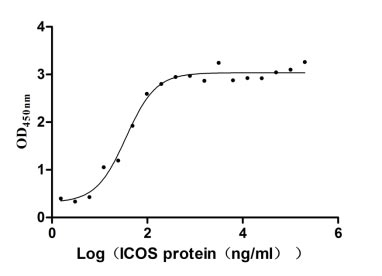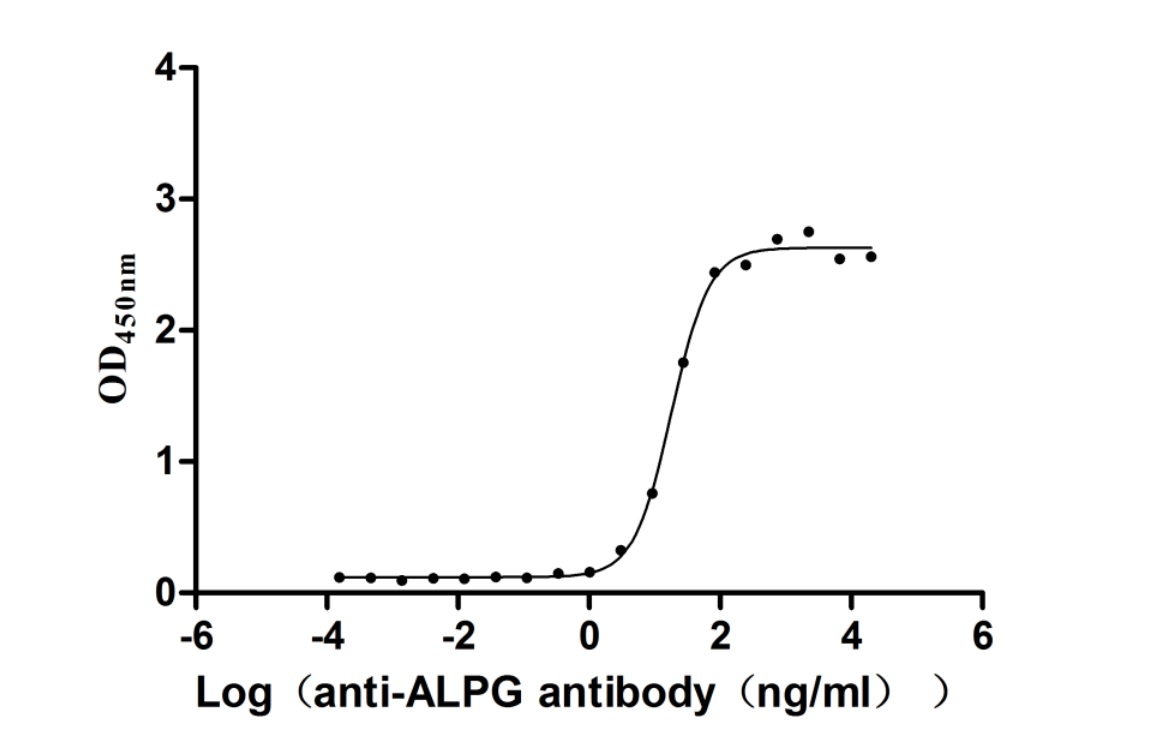Recombinant Mouse Homeodomain-interacting protein kinase 2 (Hipk2), partial
-
中文名稱:小鼠Hipk2重組蛋白
-
貨號(hào):CSB-YP882585MO
-
規(guī)格:
-
來(lái)源:Yeast
-
其他:
-
中文名稱:小鼠Hipk2重組蛋白
-
貨號(hào):CSB-EP882585MO
-
規(guī)格:
-
來(lái)源:E.coli
-
其他:
-
中文名稱:小鼠Hipk2重組蛋白
-
貨號(hào):CSB-EP882585MO-B
-
規(guī)格:
-
來(lái)源:E.coli
-
共軛:Avi-tag Biotinylated
E. coli biotin ligase (BirA) is highly specific in covalently attaching biotin to the 15 amino acid AviTag peptide. This recombinant protein was biotinylated in vivo by AviTag-BirA technology, which method is BriA catalyzes amide linkage between the biotin and the specific lysine of the AviTag.
-
其他:
-
中文名稱:小鼠Hipk2重組蛋白
-
貨號(hào):CSB-BP882585MO
-
規(guī)格:
-
來(lái)源:Baculovirus
-
其他:
-
中文名稱:小鼠Hipk2重組蛋白
-
貨號(hào):CSB-MP882585MO
-
規(guī)格:
-
來(lái)源:Mammalian cell
-
其他:
產(chǎn)品詳情
-
純度:>85% (SDS-PAGE)
-
基因名:
-
Uniprot No.:
-
別名:Hipk2; Nbak1; Stank; Homeodomain-interacting protein kinase 2; EC 2.7.11.1; Nuclear body-associated kinase 1; Sialophorin tail-associated nuclear serine/threonine-protein kinase
-
種屬:Mus musculus (Mouse)
-
蛋白長(zhǎng)度:Partial
-
蛋白標(biāo)簽:Tag?type?will?be?determined?during?the?manufacturing?process.
The tag type will be determined during production process. If you have specified tag type, please tell us and we will develop the specified tag preferentially. -
產(chǎn)品提供形式:Lyophilized powder
Note: We will preferentially ship the format that we have in stock, however, if you have any special requirement for the format, please remark your requirement when placing the order, we will prepare according to your demand. -
復(fù)溶:We recommend that this vial be briefly centrifuged prior to opening to bring the contents to the bottom. Please reconstitute protein in deionized sterile water to a concentration of 0.1-1.0 mg/mL.We recommend to add 5-50% of glycerol (final concentration) and aliquot for long-term storage at -20℃/-80℃. Our default final concentration of glycerol is 50%. Customers could use it as reference.
-
儲(chǔ)存條件:Store at -20°C/-80°C upon receipt, aliquoting is necessary for mutiple use. Avoid repeated freeze-thaw cycles.
-
保質(zhì)期:The shelf life is related to many factors, storage state, buffer ingredients, storage temperature and the stability of the protein itself.
Generally, the shelf life of liquid form is 6 months at -20°C/-80°C. The shelf life of lyophilized form is 12 months at -20°C/-80°C. -
貨期:Delivery time may differ from different purchasing way or location, please kindly consult your local distributors for specific delivery time.Note: All of our proteins are default shipped with normal blue ice packs, if you request to ship with dry ice, please communicate with us in advance and extra fees will be charged.
-
注意事項(xiàng):Repeated freezing and thawing is not recommended. Store working aliquots at 4°C for up to one week.
-
Datasheet :Please contact us to get it.
靶點(diǎn)詳情
-
功能:Serine/threonine-protein kinase involved in transcription regulation, p53/TP53-mediated cellular apoptosis and regulation of the cell cycle. Acts as a corepressor of several transcription factors, including SMAD1 and POU4F1/Brn3a and probably NK homeodomain transcription factors. Phosphorylates PDX1, ATF1, PML, p53/TP53, CREB1, CTBP1, CBX4, RUNX1, EP300, CTNNB1, HMGA1 and ZBTB4. Inhibits cell growth and promotes apoptosis through the activation of p53/TP53 both at the transcription level and at the protein level (by phosphorylation and indirect acetylation). The phosphorylation of p53/TP53 may be mediated by a p53/TP53-HIPK2-AXIN1 complex. Involved in the response to hypoxia by acting as a transcriptional co-suppressor of HIF1A. Mediates transcriptional activation of TP73. In response to TGFB, cooperates with DAXX to activate JNK. Negative regulator through phosphorylation and subsequent proteasomal degradation of CTNNB1 and the antiapoptotic factor CTBP1. In the Wnt/beta-catenin signaling pathway acts as an intermediate kinase between MAP3K7/TAK1 and NLK to promote the proteasomal degradation of MYB. Phosphorylates CBX4 upon DNA damage and promotes its E3 SUMO-protein ligase activity. Activates CREB1 and ATF1 transcription factors by phosphorylation in response to genotoxic stress. In response to DNA damage, stabilizes PML by phosphorylation. PML, HIPK2 and FBXO3 may act synergically to activate p53/TP53-dependent transactivation. Promotes angiogenesis, and is involved in erythroid differentiation, especially during fetal liver erythropoiesis. Phosphorylation of RUNX1 and EP300 stimulates EP300 transcription regulation activity. Triggers ZBTB4 protein degradation in response to DNA damage. Modulates HMGA1 DNA-binding affinity. In response to high glucose, triggers phosphorylation-mediated subnuclear localization shifting of PDX1. Involved in the regulation of eye size, lens formation and retinal lamination during late embryogenesis.
-
基因功能參考文獻(xiàn):
- Protein levels of HIPK2 were increased in high glucose or TGF-beta-treated mouse glomerular mesangial cells. The HG- or TGF-beta-induced upregulation of p-MeCP2, NOX4 and primary miR-25, but downregulation of precursor and mature miR-25, were attenuated by Hipk2 siRNA. The SIAH1/HIPK2/MeCP2 axis played a novel role for in suppressing miR-25 processing and thereby upregulating NOX4 in early diabetic nephropathy. PMID: 27941951
- Novel insights regarding the specific contribution of circHIPK2 to astrocyte activation in the context of drug abuse as well as for the treatment of a broad range of neuroinflammatory disorders. PMID: 28786753
- Data show that HIPK2-T566 phosphorylation contributes to UV-induced HIPK2 activity but it is dispensable for doxorubicin response. PMID: 28060750
- reveal a previously unrecognized role of HIPK2 activation in ER-stress-mediated neurodegeneration and its potential role as a biomarker and therapeutic target for amyotrophic lateral sclerosis PMID: 27321923
- Results indicate that Hipk2 exerts a relevant role in the survival of cerebellar Purkinje cells and that Hipk2 genetic ablation generates cerebellar dysfunction compatible with an ataxic-like phenotype. PMID: 26633710
- HIPK2 is ubiquitinated upon heat shock. PMID: 26972256
- Homeodomain-interacting protein kinase 2, a novel autoimmune regulator interaction partner, modulates promiscuous gene expression in medullary thymic epithelial cells. PMID: 25552543
- Hipk2 has an essential role in mouse white fat development PMID: 24785298
- Data indicate a critical kinase HIPK2 function in cytokinesis and in the prevention of tetraploidization. PMID: 22658722
- Hipk2 is a haploinsufficient tumor suppressor gene for mouse lymphoma development. PMID: 21785465
- HIPK2 is an important transcriptional cofactor that regulates bone morphogenetic protein signaling in the maintenance of enteric neurons and glia. PMID: 21957238
- HIPK2-mediated phosphorylation of PDX1 at Ser-269 might be a regulatory mechanism connecting signals generated by changes in extracellular glucose concentration to downstream effectors, thereby influencing islet cell differentiation and function. PMID: 20637728
- Expression of Hipk2 in the mouse nucleus accumbens is modulated by a sequence variant (B2 SINE indel) in the 3' UTR of Comt (catechol-O-methyltransferase). PMID: 20808911
- Hipk2 plays an important role in some but not all aspects of normal terminal erythroid differentiation. PMID: 20231426
- FLT3 and CD43 signaling pathways involve STAT5A via Fiz1 and Hipk2 in B lymphoblastic lymphomas. PMID: 20360400
- activates p53 by directly phosphorylating it at Ser 46 PMID: 11780126
- HIPK2 is expressed late in embryogenesis and preferentially in retina, muscle, and neural tissues. PMID: 11798164
- Hipk2 promotes apoptosis by downregulating Ctbp. PMID: 14567915
- HIPK2, through regulation of Brn3a-dependent gene expression, is a critical component in the transcriptional machinery that controls sensory neuron survival PMID: 15492043
- HIPK2 is an upstream protein kinase for Pax6 that may modulate Pax6-mediated transcriptional regulation PMID: 16407227
- The findings reported here indicate mousep53-ser58 as the mouse homolog of humanp53-serine46. PMID: 16729035
- overexpression of HIPK2 in aorta-gonad-mesonephros cultures impeded the expansion of CD45(low)c-Kit(+) cells, which exhibit the immature hematopoietic progenitor phenotype PMID: 17064687
- These findings establish HIPK2 as an MDM2 target and support a model in which, upon nonsevere DNA damage, p53 represses its own phosphorylation at Ser46 due to HIPK2 degradation. PMID: 17349959
- HIPK2 has a critical role in maintaining the transactivation activity of wtp53; low expression of HIPK2 may impair the p53 function in tumors harboring wtp53 PMID: 18483253
- Evidence for a mechanism by which IPF1/PDX1 transcriptional activity, pancreas and/or beta-cell function, is regulated. PMID: 18772243
顯示更多
收起更多
-
亞細(xì)胞定位:Nucleus, PML body. Cytoplasm.; [Isoform 2]: Nucleus. Cytoplasm. Note=Isoform 2 seems to be both nuclear and cytoplasmic.
-
蛋白家族:Protein kinase superfamily, CMGC Ser/Thr protein kinase family, HIPK subfamily
-
組織特異性:Ubiquitous. Abundant in muscle, heart, small intestine, stomach, kidney and brain; and low in testis, skin and lung.
-
數(shù)據(jù)庫(kù)鏈接:
Most popular with customers
-
Recombinant Human ICOS ligand (ICOSLG), partial (Active)
Express system: Mammalian cell
Species: Homo sapiens (Human)
-
Recombinant Human Intestinal-type alkaline phosphatase (ALPI) (Active)
Express system: Mammalian cell
Species: Homo sapiens (Human)
-
Recombinant Human Claudin-6 (CLDN6)-VLPs (Active)
Express system: Mammalian cell
Species: Homo sapiens (Human)
-
Recombinant Human Alkaline phosphatase, germ cell type (ALPG) (Active)
Express system: Mammalian cell
Species: Homo sapiens (Human)




-AC1.jpg)










